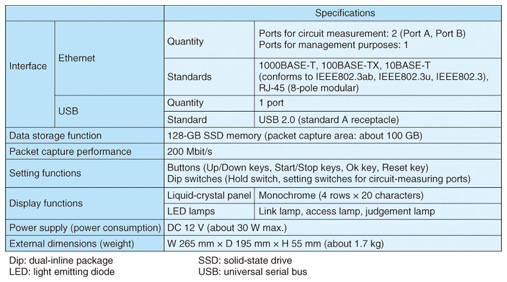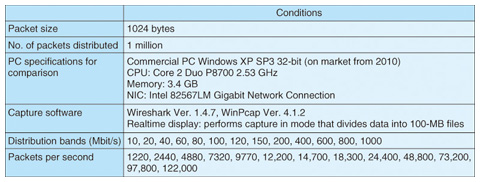 |
|||||||||
|
|
|||||||||
|
Feature Articles on Technical Solutions to Real-world Problems Vol. 10, No. 7, pp. 15–18, July 2012. https://doi.org/10.53829/ntr201207fa3 Gigabit-compatible Protocol CheckerAbstractNTT EAST Technical Assistance and Support Center has developed a protocol checker that has gigabit-per-second ports as a tool for troubleshooting IP-related faults within a customer's residence (IP: Internet protocol). This protocol checker, which can be easily installed inside the residence by a simple procedure, features remote login and straightforward protocol checking functions. It is a promising device for investigating the causes of IP-related phenomena that have low reproducibility.
1. IntroductionHome networks are reaching the gigabit-per-second level as in NTT’s FLET’S HIKARI NEXT broadband access service [1], and the ways that customers use Internet protocol (IP) services are going beyond triple-play services to include network-based games, multipoint connections via a virtual private network (VPN), and other formats. As a consequence, a greater variety of IP-related faults is occurring. In particular, the following types of faults are showing a noticeable increase.
To research the causes of these two types of faults, we developed a gigabit-compatible protocol checker (Fig. 1), which has gigabit-per-second ports. It can be easily installed inside a residence to perform packet capture and remote maintenance. Moreover, its packet capture function can handle the high-speed version of FLET’S HIKARI NEXT [2].
2. FunctionsThis protocol checker is a piece of hardware equipped with two gigabit-per-second ports for mirroring purposes and one local area network port for remote access. Equipment specifications are listed in Table 1.
In addition to a packet capture function, the protocol checker includes several functions that facilitate troubleshooting within a residence and simplify long-term monitoring. These functions are summarized below and shown in Fig. 2.
(1) Packet capture function: Packet capture can be performed by simply pressing the Start button on the top panel of the protocol checker. A hold function is also provided to prevent erroneous operation during the capture process and for reassurance to any customers concerned about installing the protocol checker. (2) Remote connection/maintenance function: This function enables the protocol checker to be remotely controlled from the maintenance center via a preset connection to a remote server after the protocol checker has been installed at the site having the fault to be repaired. It automatically establishes a VPN with the server at the maintenance center by using point-to-point tunneling protocol (PPTP). (3) Automatic transfer function: This function automatically transfers packet-capture files to the maintenance center, thereby eliminating any fears of exceeding the SSD capacity during long-term monitoring. (4) Stream check function: For audio and video services, this function stores packet loss counts and detects jitter that exceeds user-defined threshold values without accumulating captured data. It can also illuminate red lamps on the protocol checker unit and output a log. The protocol checker’s circuit-measurement ports can also detect frame check sequence (FCS) error frames. 3. PerformancePacket capture in a gigabit (gigabit-per-second) environment is commonly carried out using a gigabit switching hub set to mirroring and a notebook personal computer (PC) equipped with a gigabit port. However, an increase in the amount of traffic may cause some packets to be missed depending on the performance of the PC’s central processing unit (CPU), memory, and network interface card (NIC). These missed packets may be erroneously construed as packet loss due to an equipment fault. The gigabit-compatible protocol checker exhibits sufficient packet-capture performance compared with a PC. The results of a test comparing the packet-capture performances of an ordinary commercial PC and the gigabit-compatible protocol checker are shown in Fig. 3. The horizontal axis shows the distribution band and the vertical axis shows the capture rate (number of captured packets ÷ number of distributed packets). The number of packets per second corresponding to the distribution band is shown along the top of the graph. The distribution band was increased from 10 Mbit/s to 1000 Mbit/s (1 Gbit/s). An example of test conditions is given in Table 2.
For a packet size of 1024 bytes, these results show that the gigabit-compatible protocol checker could perform loss-free packet capture up to 1000 Mbit/s (upper limit)*. By contrast, packet loss on the commercial Windows PC caused a dramatic drop in the capture rate to begin at around 70 Mbit/s and eventually resulted in a capture rate of about 50% at 200 Mbit/s (the upper limit of service provided to each home in the high-speed version of FLET’S HIKARI NEXT). The test also revealed that packet loss occasionally occurred even in the 10- and 20-Mbit/s bands when packet capture was performed using the Windows PC. Accordingly, the specifications of a PC used for packet capture at a customer’s residence should be examined in detail. Moreover, it is recommended that the gigabit-compatible protocol checker introduced here be used in the case of a customer environment with heavy network usage as in the case of multipoint VPN connections or the HIKARI DENWA OFFICE A (ACE) telephone service.
4. Concluding remarksThe ongoing diversification of services is being accompanied by an increase in IP-related faults occurring within customer residences. To enable us to better understand a fault that has low reproducibility, affected customers must allow us to install packet capture equipment inside their residences over the long term so that the data-capture file can be analyzed when the fault reappears. The gigabit-compatible protocol checker is a tool designed for long-term monitoring: it is easy to operate, can perform remote maintenance, has a small, space-saving footprint, and features key lock protection. Its packet capture performance is high enough to handle the high-speed version of FLET’S HIKARI NEXT. It was released in September 2011. NTT EAST is currently conducting public relations activities in the form of product introductions, how-to-use seminars, and equipment rentals with the aim of having the gigabit-compatible protocol checker used in all prefectures and regions of Japan. References
|
|||||||||





